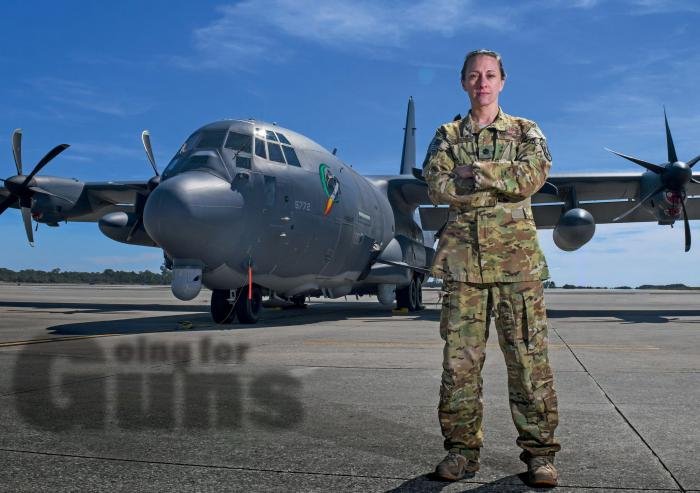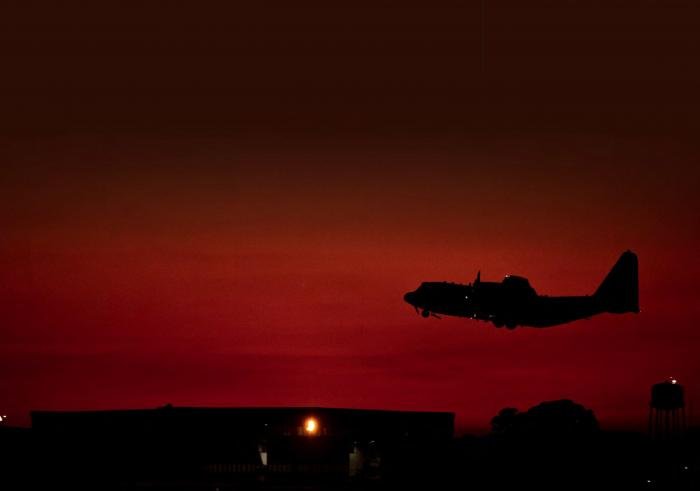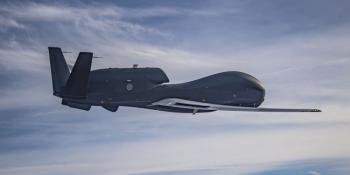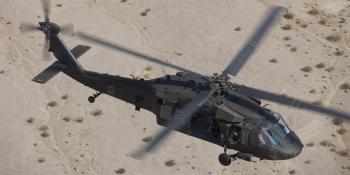Gunships have been on call to support allied ground forces in almost every combat theatre the US has been involved in since the Vietnam War. Khalem Chapman explores the past, present and future of these famed ‘angels of death’.

For more than half a century the US Air Force (USAF) has generally been the sole long-term operator of large, fixed-wing gunship platforms. Spending their operational careers out of the public eye and under the umbrella of USAF Special Operations Command (AFSOC), gunship platforms attracted little interest, but have gradually permeated to other air forces and away from traditional manufacturers.
Even following the advent of unmanned combat air vehicles (UCAVs) – a somewhat indirect modern competitor to the manned gunship – the Vietnam-era concept has remained relevant and on top of its game through the addition of the latest weapons and technologies, along with hugely positive mission success rates and feedback from top military brass and ground forces in the battlespace.

Gunship Origins
The term gunship (a synonym of ‘gunboat’) has its origins in the American Civil War, referring to the heavily armed ironclad steamships used by the opposing forces at the time. In aviation, the term gunship was first coined by the US Army Air Force (USAAF) during World War Two. It experimented with heavily armed bombers to act as escorts within larger strike formations over the European theatre, mainly triggered due to a lack of available escort fighters. This resulted in a small number of Boeing YB-40 Flying Fortresses and Consolidated XB-41 Liberators being used. However, the latter remained a prototype. The USAAF also developed the North American B-25G/H Mitchell, with both variants being used in anti-shipping and ground attack operations. The variants proved far more successful than their bomber counterparts.

Fast-forward to the 1960s, with the Vietnam War in full flow, and Project Tailchaser directed by Capt John C Simons, was spearheading fixed-wing gunship development. A Convair C-131B modified with a single GAU-2/A minigun mounted on the left-hand side of the fuselage at a downward angle was used initially. This arrangement was related to a technique that was dubbed the pylon turn, which has since formed the basis of modern gunship engagement tactics and is still the manoeuvre of choice for gunship crews today. A pylon turn is demonstrated when an aircraft circles an area in such a manner that its wingtip points towards the ground, creating a fixed turning centre. This is created when three parameters (speed, altitude and angle of bank) come together. The turn itself forms an imaginary cone shape, which harmonises the gunship’s armaments towards its apex.
Tailchaser was suspended due to a lack of funding, but was subsequently revitalised after Capt Ron W Terry returned from Vietnam, impressed by the role C-47s and C-123s were fulfilling orbiting fortifications during night attacks and acting as flare ships. The project was reactivated and subtly renamed Project Gunship.

The restart saw the replacement of the C-131B with a C-47D, which was subsequently rebranded as the Douglas AC-47D ‘Spooky’, a type that was to pave the way for gunships as we know them today. Also known as ‘Puf the Magic Dragon’ or ‘Dragonship’, the AC-47D first saw active combat over Vietnam just before Christmas 1964, armed with three 7.62mm GAU-2/M134 miniguns or ten 30-in Browning AN/M2 machine guns. The aircraft helped repel a Viet Cong attack on a Special Forces outpost at Tranh Yend in the Mekong Delta. The ‘Spooky’ crew fired roughly 4,500 rounds of ammunition before the enemy retreated. In December 1964, AC-47D ‘Spookys’ took part in 16 combat sorties, each of them accomplished successfully, cementing the gunship’s place in the USAF’s inventory.
The USAF didn’t stop there. The success of the AC-47D triggered ‘Project Gunship II’ and ‘Project Gunship III’, resulting in the Lockheed AC-130A Spectre, Fairchild AC-119G Shadow and AC-119K Stinger, respectively. The AC-119G/Ks enjoyed only a short stint in USAF service. The air force needed a platform to keep up with the demands of the mission and to effectively replace the underpowered and vulnerable AC-47Ds, while supplementing the new AC-130A aircraft that were heavily tasked over the Ho Chi Minh Trail. The USAF first deployed the AC-119 in 1968 under the 14th Special Operations Wing (SOW), but the type’s US service life ended in 1971 after some 52 AC-119G/K gunships had been acquired

Heavy-hitting Herc
‘Project Gunship II’ was hugely successful, ultimately leading to a gunship Hercules that would serve the USAF for more than half a century. The AC-130A was a modified version of the venerable C-130 Hercules tactical transport aircraft. Introduced in 1968 – seven years after America first sent troops over to Vietnam - the platform undertook ground attack, force protection, air interdiction and close air support (CAS) roles. The AC-130 quickly became a valued asset of the US forces, with its long endurance and armament comprising four 7.62mm GAU-2/A miniguns and four 20mm M61 Vulcan six-barrelled rotary cannons. By the end of US involvement in the Vietnam War, the AC-130 had been charged with patrolling the Ho Chi Minh Trail but they were also reportedly involved in the Tet Of ensive, being based from Tan Son Nhut Air Base near Saigon.
As the decades went by, the AC-130 remained at the forefront of new technology integration within AFSOC. Indeed, since its introduction, there have been seven different AC-130 variants, each breaking new ground in fielding state-of-the-art technologies. From the AC-130A Spectre there followed the AC-130E Pave Spectre, AC-130E Pave Aegis, AC-130H Spectre, AC-130U Spooky II, AC-130W Stinger II and now the latest incarnation embodied in the Lockheed Martin Super Hercules: the AC-130J Ghostrider.
The various incarnations of AC-130 help chart the development of gunship technology. The AC-130E saw the introduction of the heavy-hitting 105mm M102 howitzer, which became the mainstay of the AC-130 family. The General Dynamics 25mm GAU-12/U Equalizer five-barrelled rotary cannon followed on the AC-130H (from 2000) and AC-130U before being replaced by the 30mm ATK GAU-23/A auto-cannon that features on the AC-130W Stinger II and now the AC-130J.

Rise of the Ghostrider
The USAF’s latest addition to the family is the Lockheed Martin AC-130J Ghostrider, with Boeing providing the gunship conversion and associated support equipment. The AC-130J has seen protracted development, even since it reached its Initial Operational Capability (IOC) in September 2017. It heralds an unparalleled array of new technology and weaponry for this previously rather crude approach to warfare in an era of smart weaponry and pinpoint accuracy from the air. In March 2019, Col Michael Conley, the commander of the 1st SOW, said: “The technology in this ‘fifth-generation’ gunship will ensure combat relevance in the skies above today’s battlefields and the battlefields of the future.”
Nine crew members are required to operate the AC-130J: two pilots, a combat system officer (CSO), a weapons systems operator (WSO) and five special mission aviators (including three gunners, one loadmaster and one sensor operator). The push to supersede the ageing AC-130H/Us has seen the Ghostrider pressed into combat operations. In June 2019, AC-130J Ghostriders from the 73rd SOS began flying missions in support of US-led activities in Afghanistan, taking over from the AC-130U Spooky IIs as they notched up their final combat hours. With AC-130H Spectres officially retired in 2016, AFSOC had retired seven of its ten operational AC-130Us and three of the 12 AC-130W Stinger IIs as of March 2019. The three remaining AC-130Us will stay in the US on call for contingencies and training until being retired by the end of 2020. The AC-130Ws will follow suit, leaving the AFSOC with a gunship fleet of 37 AC-130Js by 2021.
The AC-130J is created by heavily modifying a baseline MC-130J Commando II. Lockheed Martin and the USAF teamed with Boeing Defense, the Sierra Nevada Corporation (SNC), L3 ForceX and the Naval Surface Warfare Center in Dahlgren, Virginia, on the AC-130J, which includes an open architecture to allow for follow-on development and future integration of block capabilities.
The main weapons suite consists of an internal, pallet-mounted, 30mm ATK GAU-23/A auto-cannon and a 105mm M102 howitzer, plus wing-mounted GBU-39/B GPS-guided Small Diameter Bombs (SDBs) on hardpoints in place of the regular refuelling pods – as pioneered on the AC-130W – plus AGM-176 Griffin laser-guided missiles mounted internally and launched from the rear cargo door. The MBDA GBU-44/B Viper Strike glide bomb is also in its arsenal, again debuted by the AC-130W. There are a lot of similarities between the AC-130J and the US Marine Corps’ KC-130J Harvest HAWK, although this variant doesn’t field the heavy guns.
AC-130Js are also equipped with two MX-20 electro-optical/infrared sensor/laser designator pods and multiple video, data and communication links, along with the traditional side-mounted head-up display to enhance the pilot’s situational awareness in a pylon turn. Along with this, the aircraft includes a dual-console mission operation pallet (MOP) located in the cargo bay and operated by the weapons system operator (WSO) and sensor operator. Using instruments borrowed from the F-35 Lightning II, the MOP features multiple displays and control panels to guide cameras and sensors, helping the crew to acquire targets more efficiently.

Breaking New Ground
AFSOC is blazing a fresh trail for the gunship mission when it comes to the Ghostrider. The 2018 annual report from the Office of the Director, Operational Test and Evaluation (DOT&E) details the progress made with wing-mounted AGM-114 Hellfire missiles as well as internal GBU-69/B Small Glide Munitions (SGM) – not to mention high-energy lasers, sensors including the Thales I-Master Synthetic Aperture Radar (SAR) and testing of the Tactical Off-Board Sensor (TOBS). Finally, new countermeasure systems will be integrated in the Block 40 upgrade with an active Radio Frequency Countermeasure (RFCM) system from BAE Systems.
The directed high-energy laser weapon system (LWS) is a standout item in future development plans. However, little is known about this development – in June 2018, Air Force Magazine reported that the USAF was planning an operational flight demonstration of the LWS on a Ghostrider by the end of 2022. The development has had budget issues in recent years, being $58 million short of its required funding.
It’s not the first time a laser weapon has been installed on a C-130, as through 2007 to 2009 Boeing tested the Advanced Tactical Laser (ATL) on a NC-130H Hercules. The programme was cancelled in 2009, despite good results.

The Thales I-Master compact, lightweight SAR has already taken part in an ‘initial technology demonstration’, according to the DOT&E report, where it temporarily replaced the MX-20. The Thales system provides a surveillance capability with a 360° field of view, replacing the need to reposition the aircraft while allowing it to keep constant contact with a target. It also provides detailed SAR imagery, can detect and track slow moving targets, supply imagery through cloud and notice areas of ground disturbance and changes which are not visible with the human eye.
The TOBS (Tactical Off-Board Sensor) programme was commissioned by the Air Force Research Laboratory (AFRL) and has also performed an initial technology demonstration on the aircraft. It seeks to acquire small, expendable, tube-launched unmanned aerial vehicles (UAVs) to fly along a programmed orbit and enable the AC-130J to verify and engage targets in poor weather conditions or to help its crew to identify enemy air defences in the region. Multiple contractors have developed small UAVs to fit this role, such as the Raytheon Coyote and L3 Communications Stiletto. However, reports suggest Area-I’s Air-Launched, Tube-Integrated, Unmanned System (ALTIUS) has been tested with the Ghostrider. The ALTIUS is stored and launched from the USAF-standard Common Launch Tube (CLT).


While the AC-130J of ers much, it has been plagued with technical hitches. The DOT&E FY2018 Air Force Program report stated that ‘inadequate training and technical documentation caused gun calibration procedural problems’, a situation that was later rectified by the 19th SOS. The FY2017 report noted that the 30mm cannon experienced ‘excessive retriggers in full rate of fire that reduce the utility of the firing mode’, something the FY2018 report recommended was that AFSOC develop ‘quantitative criteria’ for the gun barrel replacement based on round count or other measurable gun parameters. The programme, like many others, has also suf ered delays, most of which have occurred in relation to cold weather testing at the McKinley Climatic Laboratory in Florida, due to a fire (noted in Fiscal Year 2018) and noted ‘concerns over cold-soaking short supply components likely to break at lower temperatures,’ noted in FY 2017.
Despite advanced unmanned technology being used to provide persistent overwatch, the USAF shows no sign of wanting to part ways with its gunships. The AC-130J proves that there is still a great deal of appetite for new technology in this mission. Like other niche types such as the A-10C Thunderbolt II, the AC-130 has made itself indispensable in its ability to provide organic CAS together with Special Forces in combat theatres around the world. Col Tom Palenske, a former 1st SOW commander, has commented that the AC-130J will be “the most lethal, with the most loiter time, probably the most requested weapons system from ground forces in the history of warfare.”
A True Gunslinger




AC-130s in the Line of Fire
Following the Vietnam War, the AC-130 became the sole true gunship in the US military. In the 1980s, these were active during Operation Urgent Fury in Grenada in 1983 and operating from Howard Air Base in Panama, monitoring ongoing situations in Central America, flying undercover, classified missions and engaging guerrilla camps in the region. The gunships had a primary role in Operation Just Cause, the US-led invasion of Panama.
AC-130s have seen significant action in the Middle East such as Operation Desert Storm, which included the noted Battle of Khafji in January 1991, which led to AC-130H serial 69-6567 (callsign ‘Spirit 03’) being shot down by an Iraqi surface-to-air missile (SAM) while providing overwatch for a US Marine Corps regiment. AC-130s operated in Somalia under Operations Restore Hope and United Shield from 1992-1993; Haiti for Uphold Democracy in 1994; Liberia for Operation Assured Response in 1996; and Albania for Operation Silver Wake in 1997, to support the evacuation of non-combatant US citizens. The gunship also took part in the NATO interventions over Bosnia and Herzegovina and Kosovo during the late 1990s.
The US-led ‘War on Terror’ saw AC-130s deploy to Afghanistan under Operation Enduring Freedom from 2001-2014, along with returning to the skies above Iraq from 2003-2011. Spectres and Spooky IIs were widely used during these operations, providing CAS, ground attack, base and force protection missions throughout, along with supporting Special Forces. Subsequently, AC-130s operated over Libya for Operation Odyssey Dawn in 2011 and have since regularly joined coalition forces in the fight against the so-called Islamic State (IS) across the Middle East.
The use of gunships over urban areas was widely criticised by human rights groups following an attack on a Doctors Without Borders hospital in Kunduz, Afghanistan, in 2015, after it was mistakenly identified as an enemy facility. Inquiries concluded the incident was ‘human error’ and 16 military personnel were disciplined.
Global Gunships
In recent years, several manufacturers have been proposing gunship variants of smaller transport aircraft. The Leonardo AC-27J Stinger II – proposed to the USAF in 2008 as a smaller replacement for the AC-130H/U under AFSOC’s AC-XX programme – was a heavily modified C-27J Spartan armed with either a 30mm or 40mm gun, along with precision-guided munitions. The programme was halted in 2009 after the AC-130 was chosen to be upgraded and recapitalised.
Leonardo’s MC-27J Praetorian is now in service with the Aeronautica Militare (Italian Air Force) to perform intelligence, surveillance and reconnaissance (ISR) and CAS/ground support missions. The Praetorian features an optional weapon payload with a 30mm gun, which is palletised and can be installed or uninstalled rapidly. The aircraft can also be equipped with air-to-ground munitions.
Airbus Military’s (CASA) AC-235/AC-295 are both light gunships, with the former produced under a joint development agreement between US-based Orbital ATK and Jordan’s King Abdullah II Design and Development Bureau. The modified C-235 transport was integrated with wing-mounted weapon pylons, able to carry 70mm Folding-Fin Aerial Rockets (FFAR) and AGM-114 Hellfire missiles. The aircraft has a side mounted ATK M230 30mm chain gun and is equipped with a Synthetic Aperture Radar (SAR). Two AC-235s were operated by the Royal Jordanian Air Force, but as of December 2018, the pair were both up for sale.
As with the AC-235, the AC-295 was developed by Orbital ATK and the King Abdullah II Design and Development Bureau, in partnership with Airbus Military. Other than featuring a similar configuration to the AC-235, not much is known regarding the platform’s development.


![German Eurofighter Typhoon Special Scheme [Mathias Grägel] Thumbnail](https://fullfatthings-keyaero.b-cdn.net/sites/keyaero/files/styles/listing_card/public/2019-10/eurofighter_ef-2000s_typhoon_-_special_scheme_mathias_gragel_1.jpg?h=e07ac84d&itok=Vx_J3h1V)
![German NH90 Sea Lion [Airbus] Thumbnail](https://fullfatthings-keyaero.b-cdn.net/sites/keyaero/files/styles/listing_card/public/2019-10/german_navy_nh90_sea_lion_airbus_1.jpg?h=d8102449&itok=tkjqMvmn)

